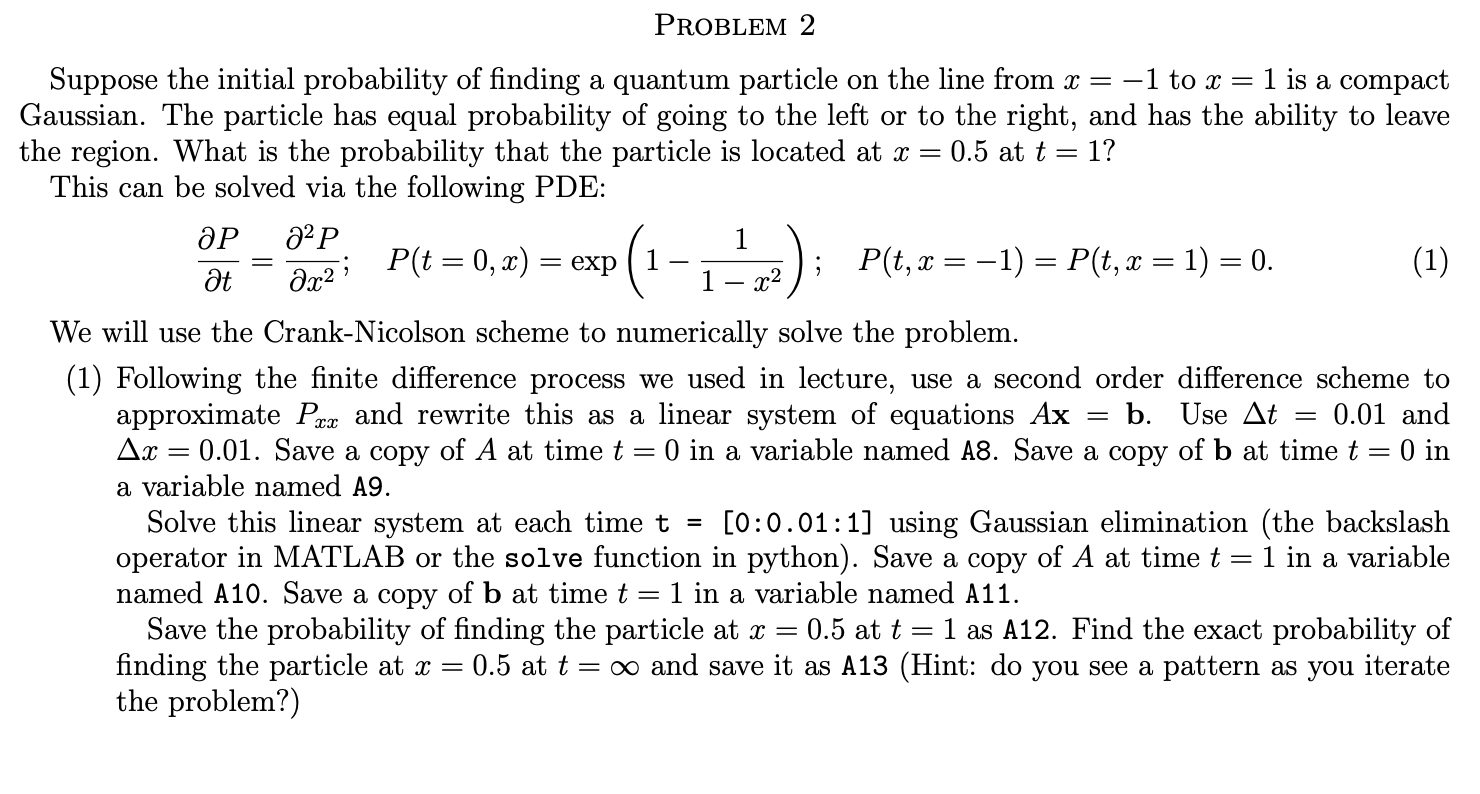Answered step by step
Verified Expert Solution
Question
1 Approved Answer
Use MATLAB please! PROBLEM 2 Suppose the initial probability of finding a quantum particle on the line from x = -1 to x = 1

Use MATLAB please!
PROBLEM 2 Suppose the initial probability of finding a quantum particle on the line from x = -1 to x = 1 is a compact Gaussian. The particle has equal probability of going to the left or to the right, and has the ability to leave the region. What is the probability that the particle is located at x = 0.5 at t = 1? This can be solved via the following PDE: 22P 1 P(t = 0, x) = exp (1 P(t, x = -1) = P(t, x = 1) = 0. (1) t x2 1 - x2 We will use the Crank-Nicolson scheme to numerically solve the problem. (1) Following the finite difference process we used in lecture, use a second order difference scheme to approximate Prx and rewrite this as a linear system of equations Ax - b. Use At 0.01 and Ax = 0.01. Save a copy of A at time t = 0 in a variable named A8. Save a copy of b at time t = = 0 in a variable named A9. Solve this linear system at each time t = [0:0.01:1] using Gaussian elimination (the backslash operator in MATLAB or the solve function in python). Save a copy of A at time t 1 in a variable named A10. Save a copy of b at time t = 1 in a variable named A11. Save the probability of finding the particle at x = 0.5 at t= 1 as A12. Find the exact probability of finding the particle at x = 0.5 at t = 0o and save it as A13 (Hint: do you see a pattern as you iterate the problem?) PROBLEM 2 Suppose the initial probability of finding a quantum particle on the line from x = -1 to x = 1 is a compact Gaussian. The particle has equal probability of going to the left or to the right, and has the ability to leave the region. What is the probability that the particle is located at x = 0.5 at t = 1? This can be solved via the following PDE: 22P 1 P(t = 0, x) = exp (1 P(t, x = -1) = P(t, x = 1) = 0. (1) t x2 1 - x2 We will use the Crank-Nicolson scheme to numerically solve the problem. (1) Following the finite difference process we used in lecture, use a second order difference scheme to approximate Prx and rewrite this as a linear system of equations Ax - b. Use At 0.01 and Ax = 0.01. Save a copy of A at time t = 0 in a variable named A8. Save a copy of b at time t = = 0 in a variable named A9. Solve this linear system at each time t = [0:0.01:1] using Gaussian elimination (the backslash operator in MATLAB or the solve function in python). Save a copy of A at time t 1 in a variable named A10. Save a copy of b at time t = 1 in a variable named A11. Save the probability of finding the particle at x = 0.5 at t= 1 as A12. Find the exact probability of finding the particle at x = 0.5 at t = 0o and save it as A13 (Hint: do you see a pattern as you iterate the problem?)Step by Step Solution
There are 3 Steps involved in it
Step: 1

Get Instant Access to Expert-Tailored Solutions
See step-by-step solutions with expert insights and AI powered tools for academic success
Step: 2

Step: 3

Ace Your Homework with AI
Get the answers you need in no time with our AI-driven, step-by-step assistance
Get Started


